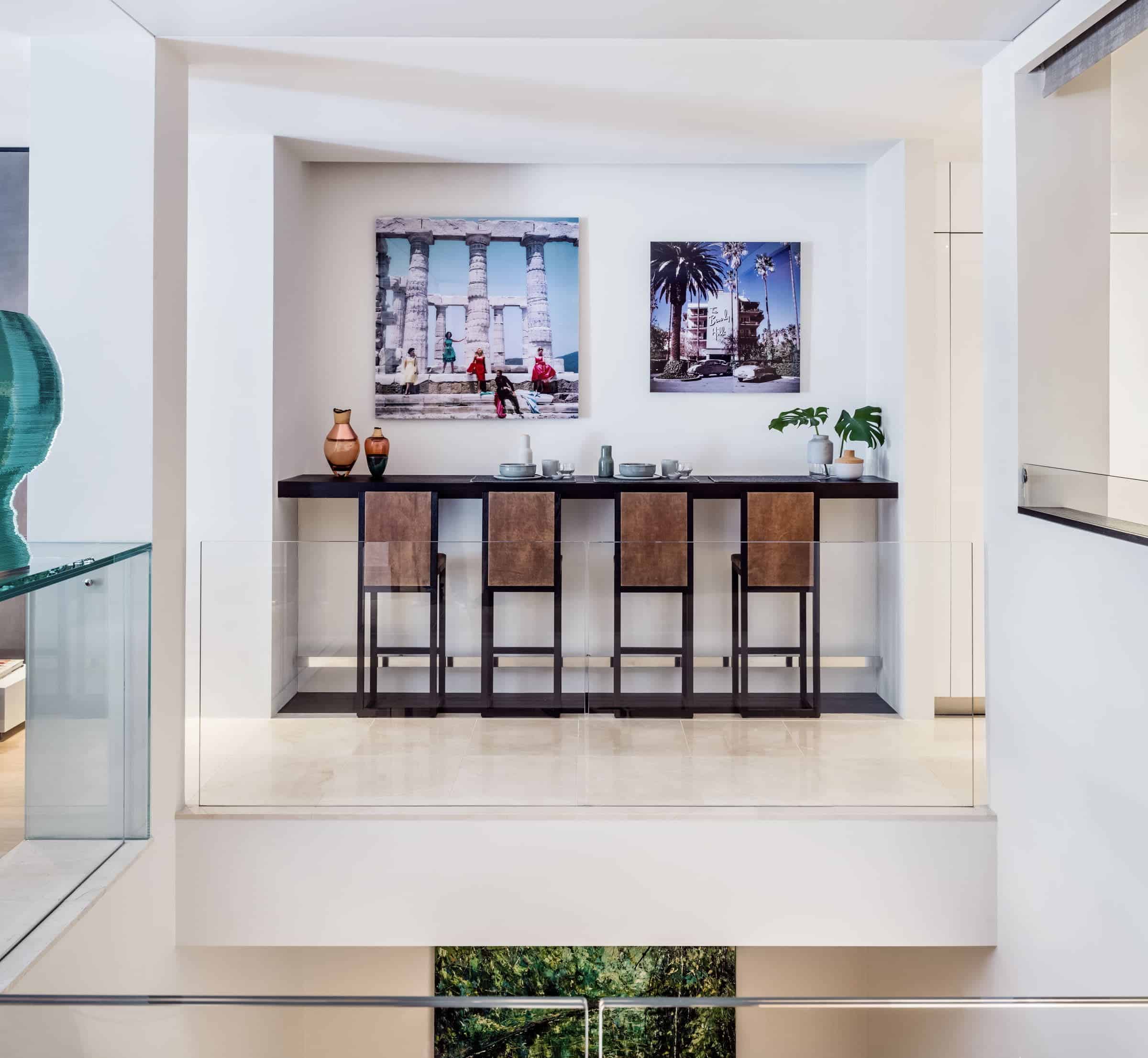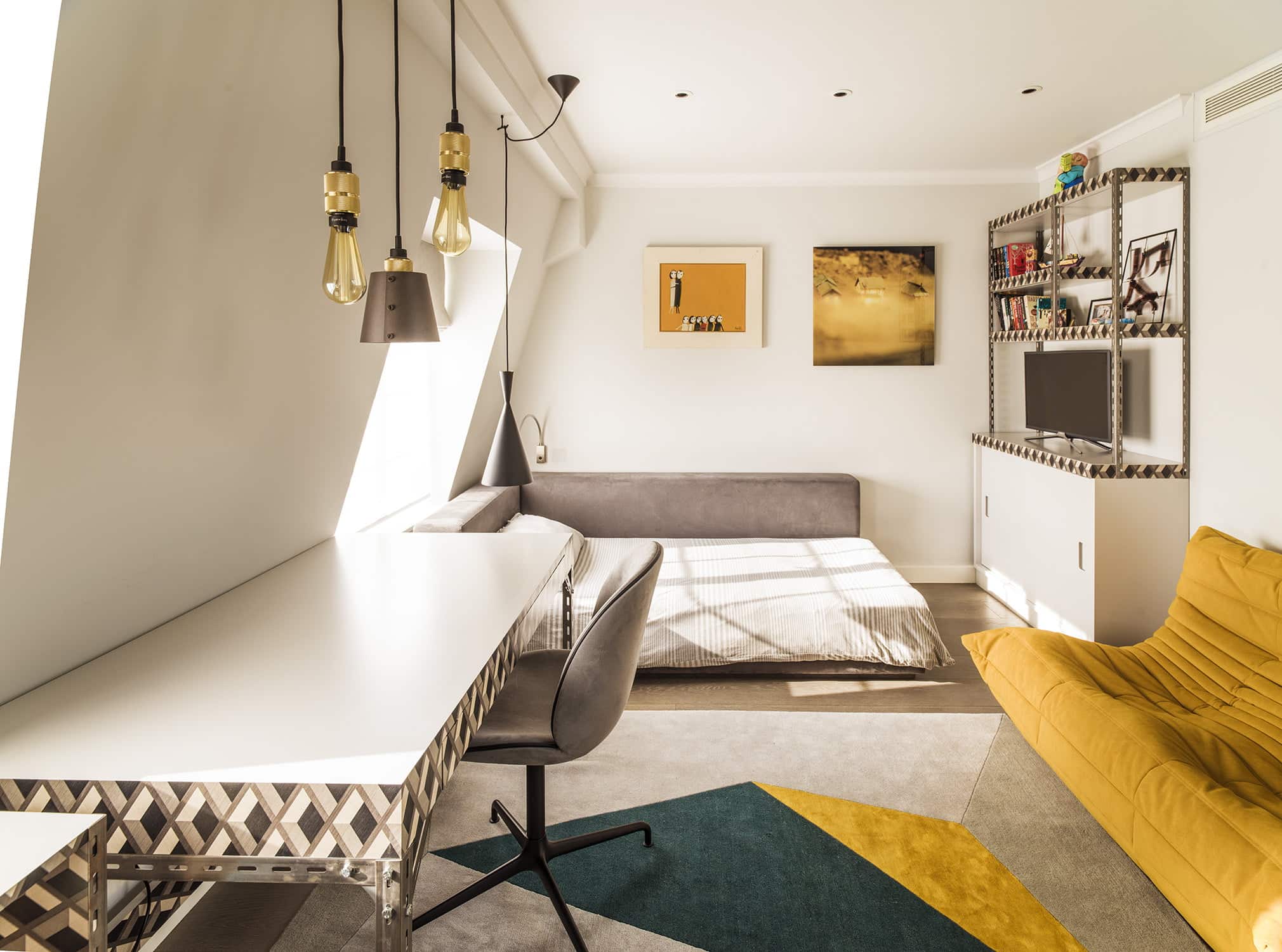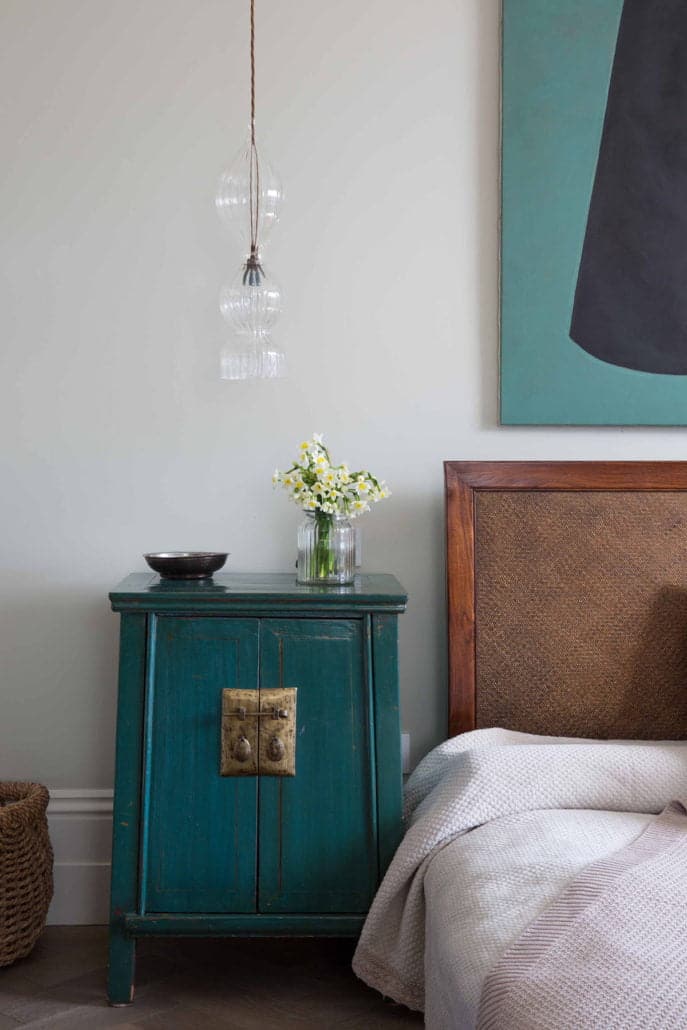Bathroom Colour Schemes & Bathroom Ideas for your Space
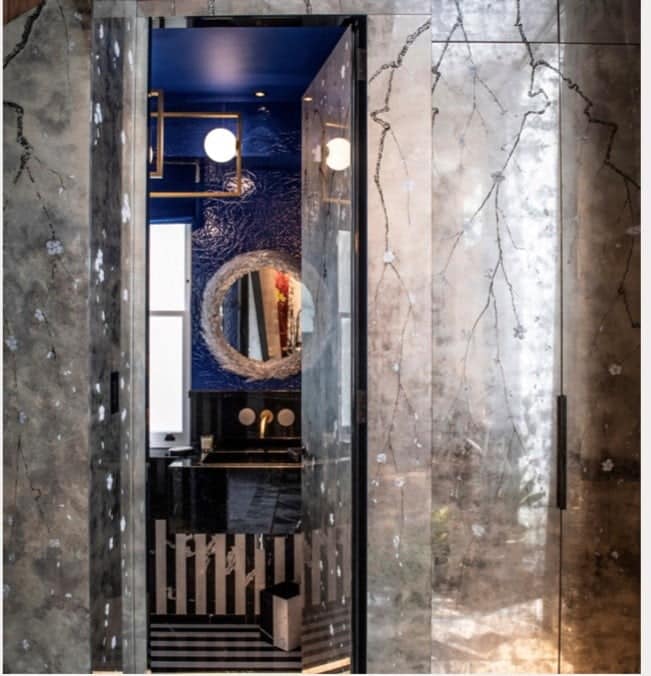
The design of your bathrooms can transform the environment into one of luxury or indulgence. Whether you’re taking a quick shower before work or rejuvenating tired muscles with a long soak in the tub, your bathroom design allows you to immerse yourself in nurturing and even decadent surroundings.
If you’re looking for bathroom inspiration ideas, you’ve come to the right place. With these handy tips, you can design a bathroom that complements the interior design throughout your property yet has its own identity. To get started, take a look at these six bathroom inspiration ideas now:
1. Start with the Colour Palette
The colour scheme is important in any room but it’s particularly critical in smaller spaces, such as bathrooms. By finding the right bathroom design colour schemes, you can make the most of the space you have available and elevate the room.
Your personal taste will be the decisive factor in choosing bathroom design colour schemes but there are lots of options to consider. Crisp whites and muted greys can create a chic, contemporary feel, for example, while using different shades of the same colour transform the space into a luxurious hideaway that ensconces and revitalises you.
If you’re looking for bathroom colour inspiration, think about the kind of feel you want to generate. A rich blue-green can add depth to a bathroom, while lighter pinks or mauves can brighten a smaller space.
For a classic yet contemporary feel, black, white and grey is hard to beat. You’ll find endless flooring options that fit within this bathroom design colour scheme and the grey vein that runs through marble makes it the ideal choice for fixtures or fittings or tiling.
2. Consider Dark Fittings
Instead of automatically selecting a white bathtub, explore the latest designs and see how much variety there is out there. A matt black rolltop bathroom can look spectacular in the right room, for example, and will undoubtedly act as a statement piece. Similarly, you needn’t stick to chrome or brass taps, handles, and accessories. A matt black, brushed steel, antique bronze, or glossy enamel can enhance the detail of your bathroom and complete the interior design.
If you’re going to adorn your bathroom with dark fixtures and fittings, be sure that they work with the colour palette you’ve selected. Fittings with a dark hue often work best with a muted shade or a lighter hue that provides balance. Alternatively, darker shades on the wall or the floor can be paired with light fixtures and fittings to achieve a sense of equilibrium.
3. Use Patterns in a Luxury Bathroom
Many people opt for single, solid colours in a bathroom because they assume that paint or tiling is the only option. While this can certainly be a good design choice, it isn’t the only way to enhance the environment. With specially designed bathroom wallpaper, you can extend your colour palette and incorporate patterns into your design too.
A floral pattern can look fantastic in a vintage-inspired bathroom, for example, while an asymmetrical patterned wallpaper could deliver a classic, retro feel. If you’re worried about overcrowding a small bathroom with patterned wallpaper, don’t be. By using tiling on the lower part of the wall and wallpaper atop it, you can incorporate patterns and colour without overshadowing the space or making it feel smaller than it really is.
4. Mix Materials for Texture and Depth
Using a combination of different materials enhances the visual impact of your bathroom and adds texture and depth too. Combining rich black or muted grey with marble, slate, or granite can give your bathroom a decadent appearance and atmosphere, for example. Alternative, exposed brickwork, terracotta hues, and copper fixtures and fittings combine to make a dream bathroom colour scheme and incorporate a range of enriching textures.
Remember – you don’t have to rely on your property’s innate features to achieve the bathroom design of your dreams. If the brickwork doesn’t lend itself to a spectacular finish, consider using reclaimed brick to recreate your own version of authentic exposed brickwork. Alternatively, high-quality tiles can be used to create the appearance of natural stone or slate.
5. Choose Spectacular Lighting
When you’re planning a bathroom redesign it’s easy to overlook the importance of lighting yet it’s one of the most critical elements. If you apply make-up in the bathroom, you’ll want to ensure that you have bright illumination atop a mirror. By incorporate layered lighting, you can opt for decorative lighting that casts a warm glow and functional lighting that provides a cool light.
Recessed lighting that sits within the ceiling, such as spotlights, are a popular option in bathrooms but think outside the box when you’re designing a luxury bathroom. Wall lights and even chandeliers can be expertly styled to take your bathroom to the next level. Providing the lights you select are designed for use in high-moisture environments, like bathrooms and kitchens, you’ll find that they can be decorative and functional.
6. Use Colour to Add Vertical Space
If you want to make your bathroom feel larger than it is, consider using colour to create the illusion of space. Using a stronger or more vibrant shade on the bottom part of the wall and a lighter hue on the top half seemingly adds height to a room and makes it feel bigger. For smaller spaces, this is an ideal way to use bathroom design colour schemes to change the impact and feel of the room.
Of course, you don’t have to rely solely on paint to achieve this effect. Using wood panelling or tiling on the lower half of a wall allows you to experiment with texture and colour, while applying paint in a lighter shade above it ensures the room will feel larger.
Designing a Dream Bathroom
The bathroom is a key part of any home, which is why its design should be a top priority. By finding the right colour scheme, you can lay the foundations for a luxury bathroom that allows you to immerse yourself in a world of relaxation and indulgence.
Conservatory or Garden Room Interior Ideas
Extending your property gives you the opportunity to update the floorplan, experiment with interior architecture, and even transform the exterior design of your home. Many homeowners focus on generating more space with the addition of a conservatory or garden room, and there are some advantages associated with extending your property in this way.
Of course, the success of your project will ultimately depend on how functional the new space is and how much you enjoy spending time in this new part of your home. While the original design of the structure plays a critical role in this, the interior design you choose is just as important.
Whether you’re planning a new addition, or you want to update an existing space, take a look at these conservatory or garden room ideas and create an environment that enhances your home and your lifestyle.
1. Choose Statement Rugs
A conservatory may not be the largest room in your property, so finding ways to maximise the space is essential. A statement rug enables you to enrich the room with exquisite styling, without taking up unnecessary space. When you’re looking for a rug that will act as a focal point in a conservatory or garden room, look out for organic shapes that can enhance the flow of any room, like the Panorama Rug in Wool and Silk by Hommes Studio:

2. Use Vertical Space Wisely
In many rooms, using vertical space can be a fantastic way to open up the space and optimise your interior design. In conservatories or garden rooms, however, it’s important to be strategic about how much vertical space you use.
If you have a floor-to-ceiling panoramic window or trifold doors, for example, you won’t want to block natural light from illuminating the room by placing tall or heavy furniture in its path. Instead, use wall coverings or artwork to style the vertical space, without it feeling cumbersome.
When it comes to furniture, minimalist or low pieces are ideal for conservatories and garden rooms. The Gold Radius Marble Coffee Table by Alex Mint highlights just how easy it is to combine luxury design with clean lines and low heights:
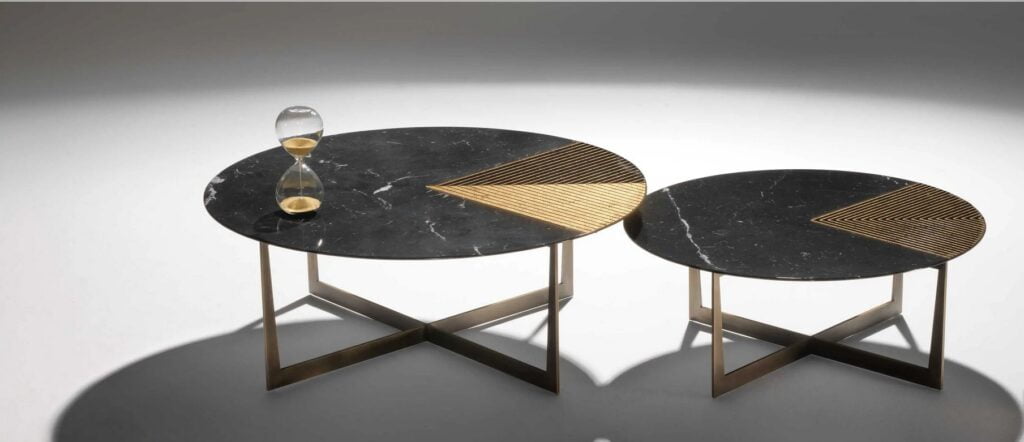
Similarly, you won’t want to use up floorspace unnecessarily in a conservatory or garden room, so use smaller pieces that have a big visual impact. With a diameter of just 40cm and a height of 55cm, the Coronum Coffee Table Small by Scarlet Splendour works exceedingly well in smaller spaces, for example, but its glossy gold finish and optional sheepskin cover ensure it will stand out and elevate the interior:
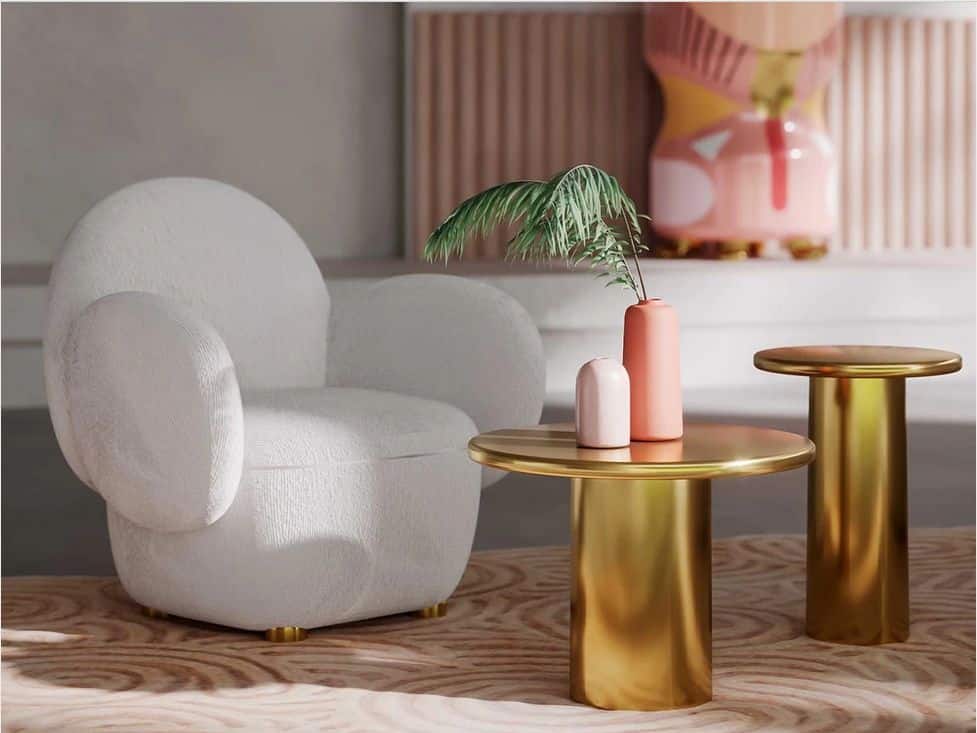
3. Specific vs Multi-Purpose
How you plan to use your garden room or conservatory will have a big impact on its styling. If you want to create a productive home office, for example, you’ll need effortless chic office furniture that maximises efficiency while inspiring and motivating you. Alternatively, if you want to enjoy a family-friendly entertainment space, comfortable seating and a relaxed atmosphere might be your top priority.
Of course, you don’t have to attach a specific purpose to your new space. If you want to make your conservatory or garden room functional for a variety of uses, be sure to factor this into your design choices. Choose furniture that’s easy to move or modular pieces that can be adjusted to suit ever-changing needs. Similarly, you may want to opt for neutral colour palettes that combine relaxation with resilience to create a malleable space.
4. Don’t Overlook Lighting
When you imagine yourself enjoying your conservatory or garden room, you probably envisage yourself making the most of the warm weather and watching the sun’s rays bounce off your garden. This is precisely why many people overlook the importance of lighting in a conservatory or garden room.
Contrary to popular belief, a conservatory or garden room doesn’t just serve as a great space during daylight hours! If you want to create an indoor-outdoor dining area, it could be the ultimate space to host dinner parties or cocktail evenings, for example. Alternatively, turning a conservatory or garden room into a second living area or an entertainment space means that you might spend more of your evenings here.
Due to this, it’s vital to select the right lighting. Not only will the lighting enhance the functionality of the space, but it will have a significant impact on the styling and ambience too. Soft lighting is perfect for relaxed, informal evenings, while something that catches the eye without taking up to much space, like the Dish6V Pendant in Brass by Graypants, could be ideal for elegant dining spaces and understated entertaining.
5. Prioritise Seating
There’s no doubt that you’ll want to incorporate seating into your garden room or conservatory, so make this one of your top priorities. Large or cumbersome furniture can quickly make the space feel smaller, so look out for pieces that exude comfort and style while being compact enough not to overpower the space.
The Cobra S Armchair by Collection Alexandra is an excellent example of furniture that’s smaller in dimension but big in style:
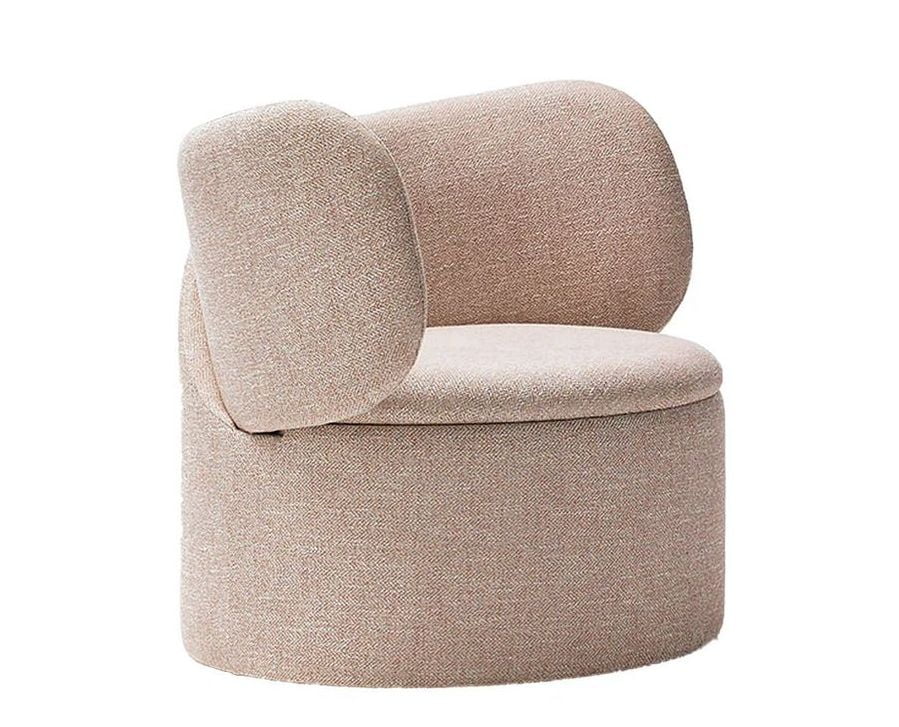
Comfort is important in any room and incorporating relaxed seating into a conservatory or garden room enables you to make the most of the view and the environment. While singular seating can work well in a home office, small sofas, stools or even a compact chaise lounge can be a fantastic addition to more informal spaces.
Designing Your Conservatory or Garden Room
Whether you’re designing a new conservatory or garden room from the ground up or you want to restyle an existing structure, there are endless options to consider. If the space is attached to your main residence, for example, retaining the flow through the property is advantageous.
While many homeowners decide to redesign a conservatory or garden room in the summer months, make sure you think about how you’ll be using the space throughout the year when you’re making design choices. By doing so, you can make the most of your conservatory or garden room and create a space that you love using all year round.
Design an Outdoor Living Space
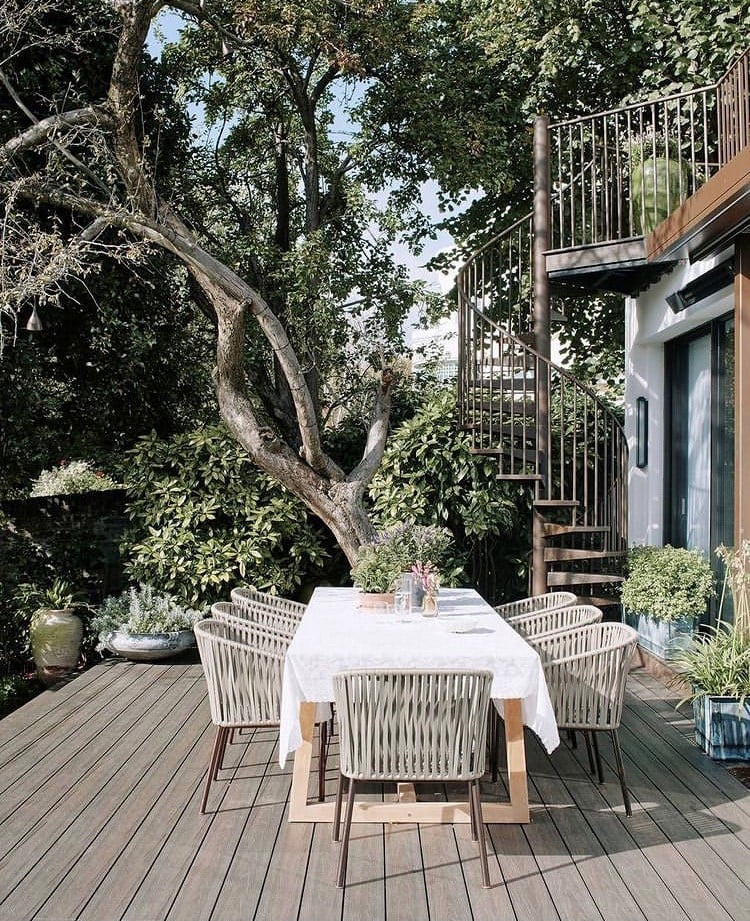
A garden allows you to enjoy your own, private outdoor haven, so it’s vital to make the most of it. By incorporating an outdoor living space, you can increase the versatility of your garden and make it even more functional. However, turning your garden into another room is about much more than simply incorporating outdoor furniture or spending a few hours in the sunshine. To find out how to design outdoor living space, take a look at these top tips now:
1. Split Your Garden into Zones
Depending on the amount of space you have available, splitting your garden into zones can be the best way to transform it into a multipurpose environment. You may choose to use some of your garden as an outdoor living space, another area as a place for homegrown fruits and vegetables, and a separate space for a rolling lawn or play area for younger members of your family.
By considering all the different ways in which you plan to use your garden, you can decide whether splitting into designating zones is the most effective way to carve out an outdoor living space. While these zones needn’t be distinct in design or have clear boundaries surrounding them, they can help you to identify your goals and priorities throughout the design phase.
2. Create a Multi-Level Space
Having a multi-level garden adds excitement and intrigue in an instant, which means it’s a great way to design an outdoor living space. If your garden isn’t on one level, trying to flatten it can be a costly, time-consuming, and ultimately futile task. By using retaining walls and designing steps, stairways and slopes, however, you can take advantage of a multi-level garden and use it as the basis of your outdoor living space.
Of course, you don’t have to miss out if your garden happens to be flat and even. With a little landscaping, you can create your very own multi-level outdoor idyll too. Earth can be added to incorporate different layers into your garden, for example, or patios and decks can be raised to achieve a multi-level aesthetic.
3. Combine Hard and Soft Landscaping
Both hard and soft landscaping can be used in a garden environment but combining them enables you to achieve a balance between the different elements. Paving over a large proportion of your garden to create a large patio might leave the space feeling devoid of nature, for example. However, filling the space with blooming potted plants and using climbing flowers as a backdrop helps to balance the hard landscaping of the patio with the soft landscaping of the plants, flowers, and shrubs.
When you’re looking for outdoor living room ideas, remember that you’re likely to use a selection of furniture in the new space. This can enhance the visual impact of hard landscaping, so be sure to balance this with plants, trees, and shrubs to create a tranquil environment and stabilise the aesthetic.
4. Evoke All of the Senses
There’s no doubt that you’ll want to create a visual impact with your outdoor living space, but why stop there? When it comes to outdoor living room ideas, aim to evoke all of the senses with the features and design themes you choose.
Installing a water feature ensures you can listen to the rippling water as you relax in your garden, for example, while planting fragrant herbs and plants, such as lavender or lilacs, means you’ll be surrounded by enticing aromas every time you step outside.
Similarly, using a range of textures in your outdoor living space can add depth to your design but it also satisfies your sense of touch. From the fabric you choose for outdoor seating to the materials used in sculptures, there are a variety of ways to ensure your new outdoor living space evokes the senses.
5. Extend Your Home
Once you know how to design an outdoor living space, you have the potential to extend your home, but not in the way you might think. This doesn’t involve obtaining planning permission or constructing extra walls and ceilings but rather extending the interior of your home into the great outdoors.
When your outdoor living space continues the flow and feel of your interior design, you enhance the sense of fluidity that should already be present in your property. Not only does this cater to your personal style and tastes but it also allows you to create an outdoor living space that perfectly complements the interior of your home.
By using bifold, trifold, and sliding doors or panoramic windows, you can blur the lines between indoors and outdoors even more, and create a stunning, versatile space.
6. Think About Practicalities
An outdoor living space should enable you to spend more time in your garden, but you’ll want to ensure you have the practicalities in place if you’re going to make the most of the space. This might mean extending the range of your router to ensure you can access the internet from your designated outdoor living space, for example. Alternatively, you might choose to have power outlets installed in discreet locations so that you can incorporate entertainment into your outdoor living space.
Although modifications can be made in the future, it’s easier to include these practical extras from the outset. When you build them into your design, you can use spectacular exterior design to hide wiring or fixtures, for example.
7. Use Outdoor Fabrics
Many people shy away from using fabrics outdoors, which is understandable when you consider how much rainfall we get in the UK! However, fabric is an important way of increasing comfort and helps to make a space feel more welcoming. Choosing fabrics that are designed for outdoor use, such as outdoor seating or outdoor rugs, ensures you can enhance your outdoor living space with stunning designs and textures while still selecting decorative pieces that are suitable for use outside.
Bring Your Outdoor Living Room Ideas to Life
When you increase the functionality of your garden, you effectively transform it into another room. Whether you plan on spending your days soaking up the sun, working from home, or enjoying time as a family, an exquisite outdoor living room will enhance the function, style, and versatility of your home.
Creator and Founder of The Design Buzz: Shalini Misra

Already well-known for combining interior design and architecture to create spectacular environments, Shalini Misra’s latest project involves bringing exquisite designer homeware & luxury home accessories to an audience of homeowners, designers, and creatives.
Founded in 2020, The Design Buzz came about in response to regular enquiries from friends, family, and clients who were eager to know where to source the best pieces for their own homes.
While working as an internationally acclaimed interior designer, Shalini Misra and her team came across an array of talented artisans and craftspeople. Building a network of suppliers in the UK and overseas, Shalini routinely sought out spectacular furniture and decorative pieces to enhance designs and add the finishes touches to a client’s home or workspace.
Curating up and coming talent, and making their work available to the public seemed like a natural extension of Shalini’s work and, thus, The Design Buzz was born. Using her expertise and unique insight, Shalini has selected a range of artists to showcase on the site. Featuring the highest quality home items, furniture, and accessories, The Design Buzz brings artists and homeowners together.
"The Design Buzz is a celebration of the characters and companies that we know that bring wonderful items of all kinds to our homes"
Having trained as an architect at the Delhi School of Architecture, the University of Colombia in New York, and the Bartlett School of Architecture, UCL, Shalini’s unique experience and expertise ensures she is perfectly placed to recognise up-and-coming artists, designers, and companies that can deliver exquisite quality, optimal functionality, and spectacular aesthetics.
Furthermore, her award-winning work around the world, combined with a raft of accolades, makes Shalini well-placed to meet with burgeoning craftsmen and women who are often overlooked by the mainstream. As a result, you’ll find a unique, eclectic, and enticing range of furniture, home items, and accessories at The Design Buzz that’s hand selected by Shalini and her team.
Already named one of the top 100 interior designers in House & Garden, Shalini continues to offer her services as an interior architecture and designer while taking an active role as the Creative Director of The Design Buzz.
As well as being a British Institute of Interior Design (BIID) committee member, Shalini sits on several boards and acts as a trustee and mentor of the Vahani Scholarship Trust, a UK non-profit organisation that works with underprivileged children.
Dedicated to creating inspiring spaces that optimise well-being, promote sustainability, and enrich lives, Shalini brings her energy, creativity, and talent to the fore via The Design Buzz and looks forward to helping people find fixtures, furniture, and accessories to enhance their surroundings and bringing lesser-known artists to a new audience.
Design The Perfect Entertainment Space
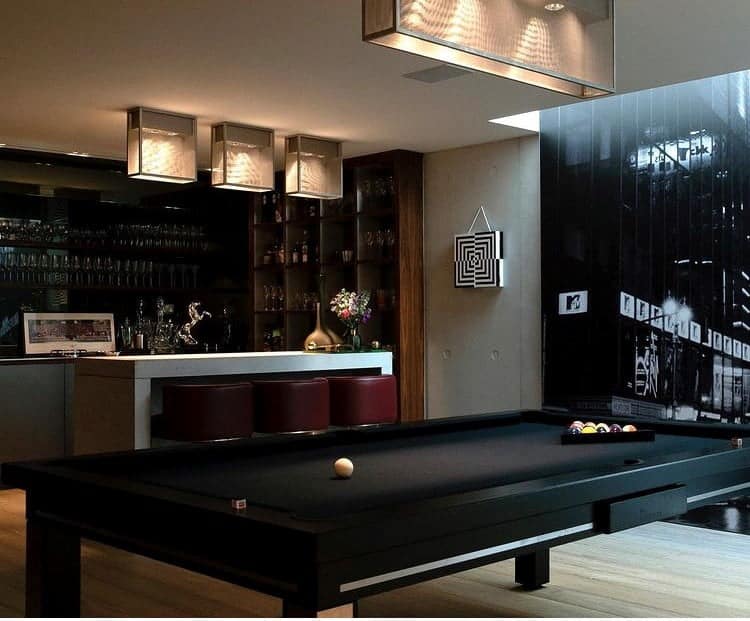
Your home is your sanctuary, which means it should fulfil all of your needs and provide you with an enriching environment. Designing a space for entertaining ensures that you have a dedicated place for escapism, fun, and relaxation.
Additionally, designating a particular area of your property as an entertainment space allows you to incorporate new design ideas and themes into your home. To get started, take a look at these top tips for designing the perfect entertainment space now:
Identify Your Entertainment Goals
Before you start planning your new space, think about what type of entertainment you enjoy and what type of events you plan on hosting. If you’re known for hosting elegant, formal dinners, for example, the dining room may be a core concept in your design. Alternatively, if you prefer more informal gatherings, you might want to create a relaxed and comfortable atmosphere elsewhere in your home.
Similarly, remember to differentiate between entertainment spaces you’re likely to use as a family or with close friends and spaces that are more suitable for larger events, such as parties. A home cinema can be a great option for families and small groups of guests, for example, whereas a home bar might be ideal for larger parties.
Designate a Space
Dedicating part of your home to entertainment is always worthwhile, so don’t hesitate to reserve part of the floorplan purely for fun. Of course, this can be tricky if every area of your home already serves a distinct purpose. If you’re designing a space for entertaining, a basement conversion and extension can be a fantastic option. Not only will you increase the square footage of your home, but you can also play a role in designing every element of the space you’re creating. With stairs leading directly from the basement area to your garden, you can even design an indoor-outdoor environment that’s perfect for entertaining.
If you want to use existing space for entertaining, consider which areas of your home you’re willing to share with guests and which spaces provide the best atmosphere. A roof terrace with a stunning view can be an ideal location for cocktail parties or drinks before dinner, for example.
Increase Fluidity
Even when an entertainment space is distinct from the rest of your home, it should never feel cut off or distant. By increasing fluidity, you can ensure that there is a natural transition between other areas of your property and your new entertainment space. You can achieve this by choosing a design and style that complements the existing interior of your home and using creating a balance between each part of your property.
If the more public areas of your home, such as the dining area, kitchen and living areas, are open-plan, it’s particularly important to ensure that new entertainment spaces enhance the fluidity of the environment, rather than diminish it.
Maximise Versatility
Entertainment trends change all of the time and there’s a good chance you’ll want to use your new space for more than just one type of event. To make this possible, focus on maximising versatility when you’re designing a space for entertaining.
Use large rugs on the floors ensures they can be moved easily and transferred to other areas within your home, for example. Similarly, portable lighting, such as floor standing or table lamps, can be transported from one area to another in seconds.
You’ll even find that some furniture designed for entertainment spaces is created with versatility in mind. Choosing a home bar that features hidden wheels or casters allows you to increase the functionality of your home and modify your entertainment space at any time.
Use Warm Hues
You want people to feel welcome, relaxed and at ease when they visit your home for entertainment purposes, so make sure you factor this into your decision-making when you’re designing a space for entertaining. Warm shades help to make a room feel more intimate, which is ideal when you want your guests to get to know one another. Furthermore, warm colours tend to convey excitement and even exuberance, which is exactly what you want to achieve when you’re creating a space for escapism and fun.
Incorporate Varied Seating
The right seating is integral when you’re creating an entertainment space, so be sure to consider this early on during the design stage. Ideally, you’ll want to incorporate varied seating options into the area, so that people can naturally gravitate to what suits them best. Sofas, chairs, and benches are ideal in an entertainment space, but stools and statement seating can work well too.
Although comfort should always be a top priority when you’re designing an entertainment space, think about the flow of traffic if you’re hosting larger events, such as parties. If you want guests to move through the space and get to know one another, choose seating that’s comfortable but that doesn’t entice people to stay in one place for too long.
Use Lighting to Create Ambience
Lighting is a core component of any room and it's particularly critical in an entertainment space. Subtle lighting wired into shelves or bookcases can increase the impact of your interior design and take a room from day to night, for example. By using a range of different options, such as lamps, wall lights and ceiling lights, you can create a layered effect that lends itself to any type of entertainment. Similarly, choosing lights that can be easily adjusted, such as dimmable bulbs, will give you total control over the atmosphere and ambience.
Enjoying Your New Entertainment Area
Once your entertainment space is complete, all that’s left to do is enjoy it! While it can take time to design the perfect space for entertaining, your hard work will be well worth it when you experience the end result. Whether you plan on hosting large-scale events or friends and family are a permanent fixture in your home, a bespoke entertainment space will provide all the fun and escapism you need.
5 Ideas To Make Your Home More Elegant
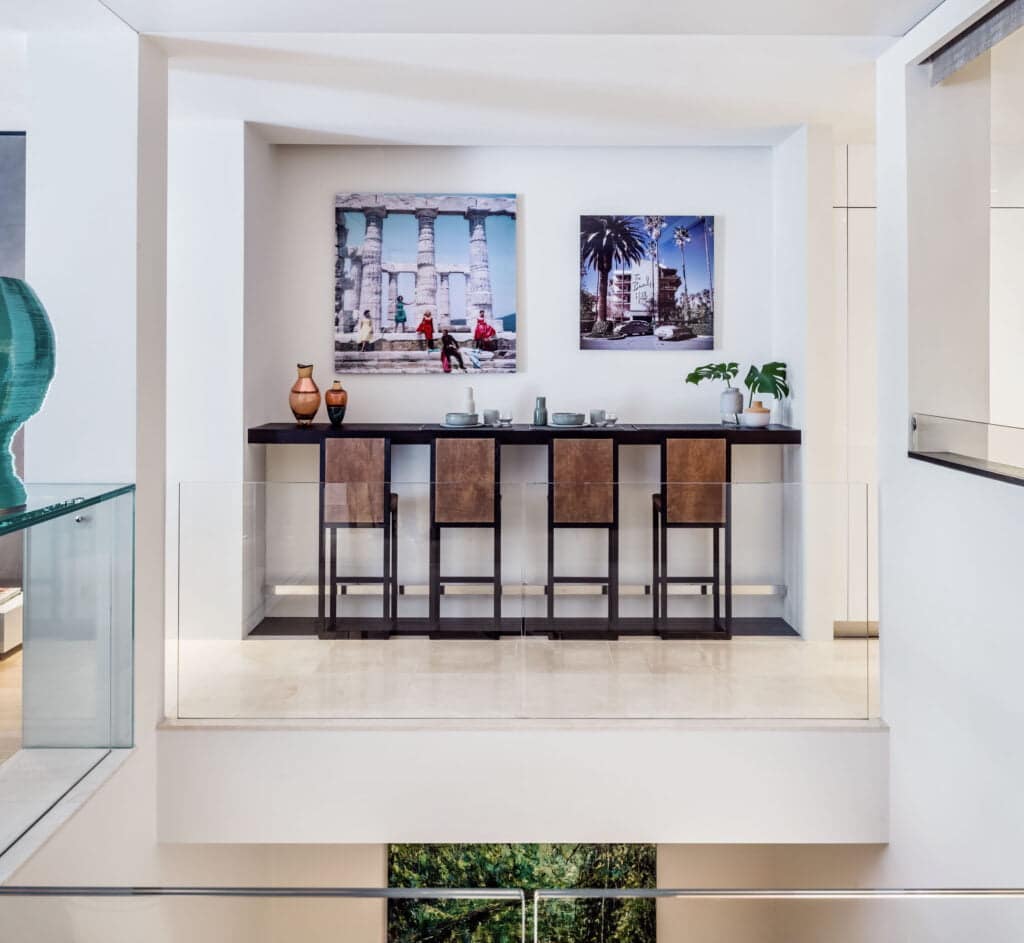
Image Credit: Cheyne Place
No matter what size or style your property is, you can create an elegant home environment that matches your style. As your haven away from the rest of the world, your home should make you feel safe and secure, but it should also be a place of freedom, creativity and relaxation. What’s more – your home should be a gift to yourself and something that represents your hard work and effort.
Before you can make your home feel more elegant, however, you’ll need to determine exactly what the term elegant means to you. By definition, an elegant home is stylish, sophisticated, charming and luxurious, but, of course, people interpret these characteristics in different ways. To get an idea of what this encompasses, take a look at these elegant home decor ideas:
1. Choose a Timeless Colour Palette
When it comes to colour, there are endless shades and hues to choose from. If you want to design an elegant home, however, selecting a timeless colour is always a good place to start. While on-trend shades can be used as accents, a classic colour palette will evoke a sense of chic sophistication that you want your home to embody.
While neutral colours can be a fantastic base in any room, don’t be afraid to experiment with bolder colours too. If you want to create a dramatic impact, for example, aubergine or dark grey walls can certainly deliver the effect you’re looking for. Alternatively, softer shades, such as mint or coral, can be ideal when you want a room to feel light and airy.
2. Use a Range of Textures
Many people mistake elegance for minimalism but the two aren’t necessarily intrinsically linked. While a minimalist interior design can certainly be elegant, you needn’t eschew decorative pieces and home comforts in order to transform your home into a charming living environment.
In fact, incorporating comfort and charm into your interior design can make your home feel more elegant than ever. Using a variety of textures will add depth to your designs, as well as making your home feel more welcoming and inviting.
A single room can feature multiple textures, depending on the materials you choose to use. A stone floor in a kitchen or hallway can be offset by softer colours on the walls, for example. Similarly, a comfy leather sofa that envelops you can combine unparalleled comfort with chic design. When you incorporate cushions and throws in different fabrics, it’s easy to see how a range of textures can take your interior design to the next level.
3. Enjoy Interesting Artwork
Incorporating art in your home will undoubtedly make it feel more elegant, but don’t stick to the status quo when you’re selecting paintings, prints, sculptures, or photography for your home. When you’re choosing which artwork to display, be sure to follow your heart and select the pieces you love. This will mean that your home is a reflection of your style and personality, as well as ensuring that you’re surrounded by art that you truly enjoy.
Remember – not all artwork needs to be hung on the wall. If you want to use art to elevate your interior design, think outside the box when you’re deciding how to display it. Leaning art against the wall or using it as a backdrop behind shelving can be an effective way to add variety to your design, for example.
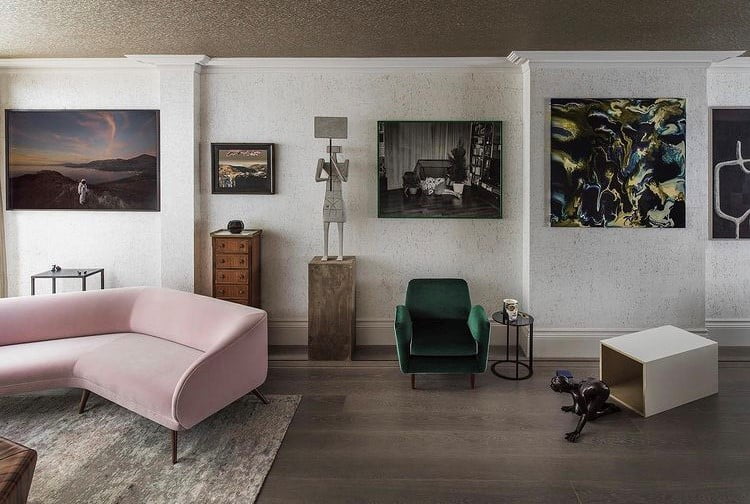
4. Make Lighting a Priority
An elegant home is always well-lit, so don’t overlook the importance of great lighting when you’re designing a room or redecorating an entire property. In fact, lighting is so important that it should be a central element of your interior design from the outset. While illumination obviously plays a functional role in any property, it also has a major impact on how a room looks and feels. Due to this, you can use lighting to create an elegant and sophisticated environment in every room.
Layered lighting works exceedingly well in a home environment, particularly in multi-purpose spaces. When you use a combination of ceiling lights, walls lights, and floor or table lamps, for example, you can modify the lighting at any time to create the perfect ambience. By choosing statement lights, you can also ensure that lamps and fixtures are in keeping with your preferred style and deliver an elegant silhouette.
5. Add Custom Features
Incorporating bespoke features into your home can increase the elegance of your interior and enable you to showcase your property at its best. With custom-made cabinetry in the kitchen, for example, you can increase the functionality of the space and establish a chic design that embodies sophistication and elegance. Additionally, bespoke crown moulding in living and dining rooms or wainscoting in the entranceway, hall or foyer is an easy yet highly effective way to make your home feel more elegant.
Of course, adding custom features to your home also ensures that your interior design will be totally unique. In an era of mass-produced furniture and popular design trends, this individuality should be cherished and treasured, so don’t hesitate to use custom-made craftsmanship, unique artisan décor and handmade decorative pieces to enhance your surroundings.

Designing an Elegant Home
When you’re renovating or redecorating your home, choosing interior design styles that can be carried through the entire property is one of the best ways to create an elegant living environment. While each room might have a distinct character, you can use interior design to ensure there is a seamless transition from one space to another.
It’s important to remember, however, that your home needs to be functional, as well as elegant. Whether you live alone, with a partner or with children, you’ll want to ensure that your living environment serves your needs and is easy to maintain. By incorporating these factors into your design choices, you can ensure that your elegant décor and sophisticated interiors will withstand the rigours of day-to-day life and create a chic home environment that inspires and envelops you.
Luxury Kids Bedroom
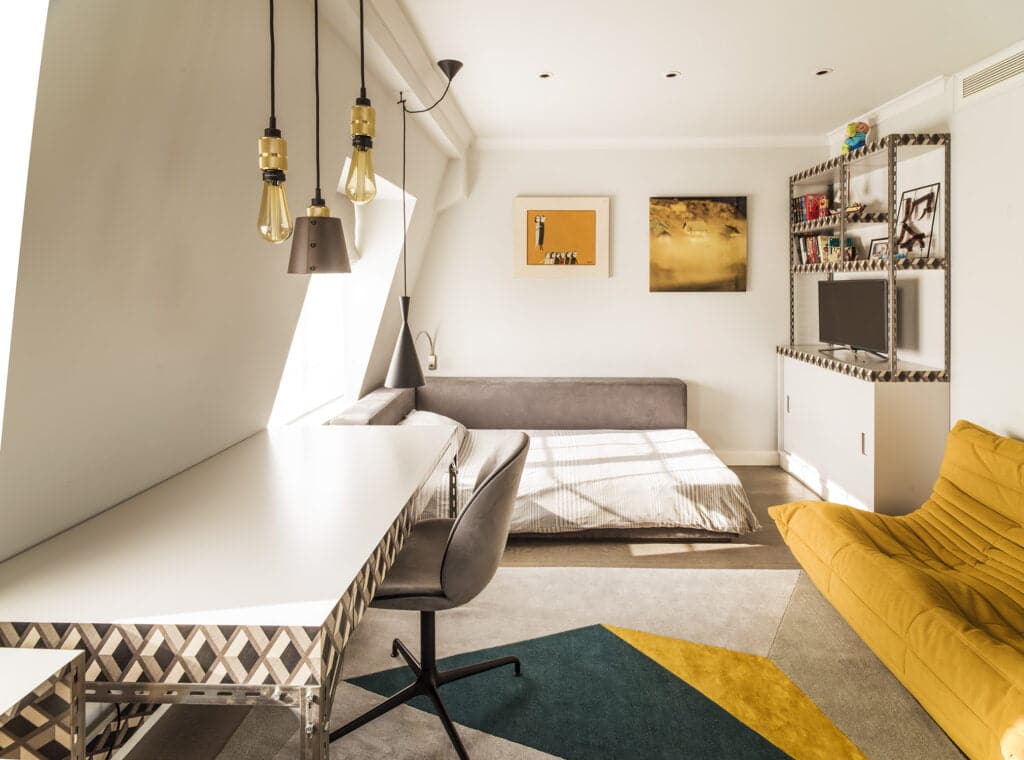
As a parent, there’s no doubt you’ll want to ensure your child has everything they need. By designing a luxury bedroom for them, you can establish a calming and tranquil environment that promotes relaxation while also creating an inspiring space that reflects their personality and potential.
Kids grow up alarmingly quickly, which is why it’s important to capture their imagination at every stage of their development. With the right styling, their bedroom can be a place of wonderment and joy, as well as a functional and versatile room. For inspiration, take a look at these top tips for designing a luxury kids’ bedroom and create the perfect place for your children to grow up in:
1. Use Colour Themes
When you’re designing a child’s room, it’s tempting to choose a theme that relates to their current interest or age. However, this typically puts a short time limit on how long your child will enjoy the décor. After all, kids regularly have new favourite animals or characters and often develop a wide range of interests as they get older.
By using a colour theme as the base for your design, you can ensure that your child’s luxury bedroom stands the test of time. Interests and hobbies can then be used to enhance the décor and updated at regular intervals. Not only does this keep the room and its design feeling fresh, but it also ensures that you can update your child’s room to reflect their changing interests and hobbies as they get older.
2. Make the Bed a Focal Point
As the bed is usually the largest piece of furniture in any bedroom, it naturally acts as a focal point. When it comes to designing a luxury kid’s room, you can really go to town and transform the bed into a statement piece of furniture and a central element of the interior design.
From fairy wonderlands with a canopy bed to an elevated bed with a built-in fort and slide, there are endless possibilities to consider. You’ll find many children’s beds that are pre-made in fun and exciting styles but if you want to create something bespoke, you can have a luxury bed built to your own specifications. This gives you the opportunity to unleash your creativity and produce something that adds the finish touches to your interior design and ensures your kid has a spectacular bedroom to enjoy.
3. Maximise Storage
No matter what age your child is, there’s a good chance they have more toys than you prepared for! Due to this, you’ll need to incorporate storage solutions into your bedroom designs to maximise functionality. This can be done in many ways, but built-in storage is often the best way to make the most of the space that’s available.
When you combine built-in storage solutions with freestanding options, such as drawers and toy chests, you can ensure that your child’s luxury room has sufficient storage space. As well as making sure the décor can be seen in its best light, this also enables you to keep the room clutter-free.
4. Bespoke Carpentry
Designing a luxury bedroom is significantly easier when you can incorporate bespoke solutions into your plans. Instead of relying on furniture with existing specifications, for example, you can have items custom-made to fit the room. Not only does this ensure that your child’s luxury bedroom will be totally unique, but it also allows you to showcase the property’s features and make the best use of the space that’s available.
In addition to this, high-quality craftsmanship really does stand the test of time, which is why bespoke carpentry and cabinetry is well worth investing in. While you might want to update the décor over time, having furniture custom-made and built-in will enable you to create a bedroom that evolves with your child as they grow.
5. Use Wall Décor to Keep the Floor Free
A child’s bedroom is often used for play, as well as for sleeping, which means you’ll want to enhance its versatility in as many ways as possible. When you maximise wall décor, you can create a stylish interior design while still leaving the floor space free to use as a play area.
Patterned wallpaper or artwork can be a fantastic way to enhance a child’s room, for example, and matching bedding and furniture will complete the design. Similarly, choosing a flooring that complements the design but promotes functionality will ensure your kid’s bedroom is easy to clean and maintain, as well as being stylish and luxurious.
6. Create a Separate Play Area
Even if your child has a separate playroom, there’s a good chance that they’ll use their bedroom as a play area too. While it’s great for youngsters to be able to use their imaginations and play with toys, a cluttered bedroom can disrupt night-time routines.
Kids need a calm and relaxing environment to promote high quality sleep in the same way that adults do. Of course, if toys are visible when you’re trying to settle your child at night, they’re likely to become distracted and want to stay up to play, rather than going to sleep.
Having sufficient storage space can go part way to solving this issue, as toys can be put away out of sight before bedtime rolls around. However, using a decorative room divider can also be an effective way of creating a separate play area within a luxury kid’s room. This will enable you to create a tranquil space for sleep and a more dynamic environment for play, without disrupting your child’s evening routine or affecting their sleep quality.
Designing a Bespoke Bedroom for Your Child
Children tend to spend an increasing amount of time in their room as they get older, which means it’s important to ensure that their room is inspiring, functional and soothing. When you use interior design to create a room that combines their interests with a calming colour palette and versatile features, you can transform the space into a luxury room that nurtures your child as they grow.
Holistic Meditation Spaces in Your Home
Meditation is a fabulous way to promote relaxation and well-being, which is why it’s worth creating your very own holistic meditation space in your home. When you have a dedicated space to meditate, it’s easier to make it part of your daily routine. Furthermore, having a tranquil environment in which to meditate can help to calm your mind and enhance the positive impact that meditation has.
If you want to create a personal sanctuary that you can enjoy at any time, or you’re eager to enhance the relaxing properties of your surroundings, take a look at these top tips for designing serene, holistic meditation spaces in your home:
Identify How Much Space You’ll Need
People like to practice meditation in different ways. Some prefer to sit cross-legged on the floor, whereas others find it more comfortable to use an upright chair or to lay down on the floor. If you’re new to meditating, remember that your preferences might change over time, so make sure you can adapt the space in the future. Once you’ve begun to think about how you would like to practice meditation, you’ll have a clearer idea of how much space you’ll need.
Dedicate a Space
Depending on the size of your home, you may wish to dedicate an entire room to meditation. While turning an empty room into a holistic meditation space is certainly a great use of your environment, you don’t have to devote an entire room to wellness. Instead, you can carve out space in an existing room and create a versatile environment that lends itself to tranquillity and calmness.
Ideally, you’ll want to choose a ‘low traffic’ area, that will allow you to meditate undisturbed. This might be a corner of your bedroom or space in a spare room. You can even turn a quiet part of your living area into a holistic meditation space if you wish.
Embrace Minimalistic Décor
The art of meditation involves clearing your mind and heightening your awareness, and minimalist décor can help you to achieve an innate sense of calmness. When you aren’t distracted by your surroundings, it can enhance your meditation practice and allow you to enter a deeper state of tranquillity.
Your surroundings have a significant impact on your mind, so be sure to clear the area before you begin thinking about what you’ll need in your meditation space. When you start from scratch, you can create a bespoke space that’s perfectly suited to the style of meditation you choose to practice.
Choose Soothing Colours
The colour of a room can evoke certain emotions. Bold reds and yellows are known to be energising, stimulating and motivating, for example. In contrast, blue is a soothing colour that calms the mind and promotes intellectual creativity, while green provides balance and harmony. Of course, neutral colours such as whites, greys and taupe, provide calm reassurance, which can be perfect for a holistic meditation space.
If you’re incorporating your meditation space into an existing room, you may not want to drastically change the décor. However, using decorative screens can be a great way to separate your meditation space from the rest of the environment. By doing so, you can use a distinct yet complementary colour palette that will promote relaxation without impacting on your core room design.
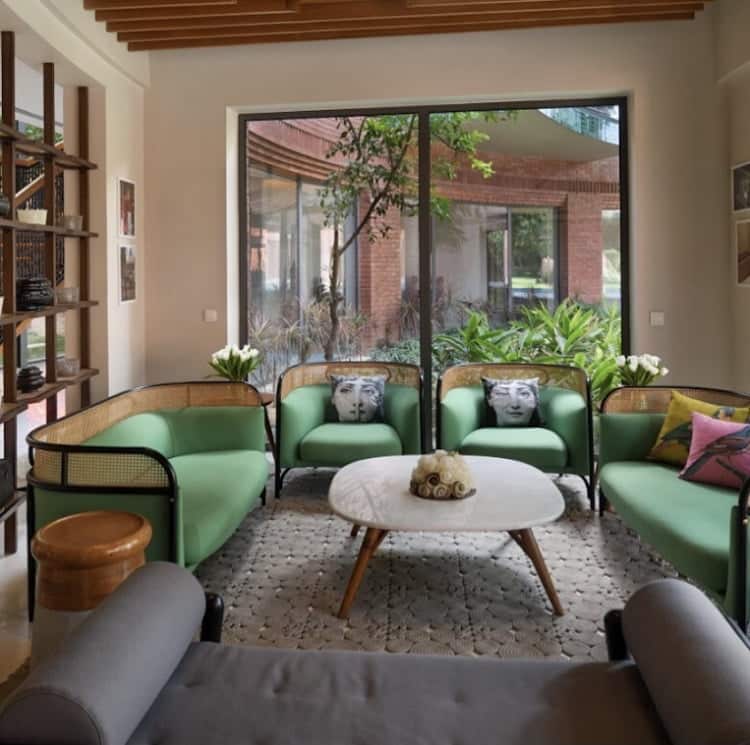
Add Soft Lighting
If you prefer to hear the sound of the great outdoors as you meditate, try and choose a space that’s close to a window. As well as giving you easy access to nature, you can allow the natural light to flow into your meditation space and use it to help clear your mind.
Alternatively, use soft lighting to illuminate the space. Candles work particularly well when you want to relax and unwind.
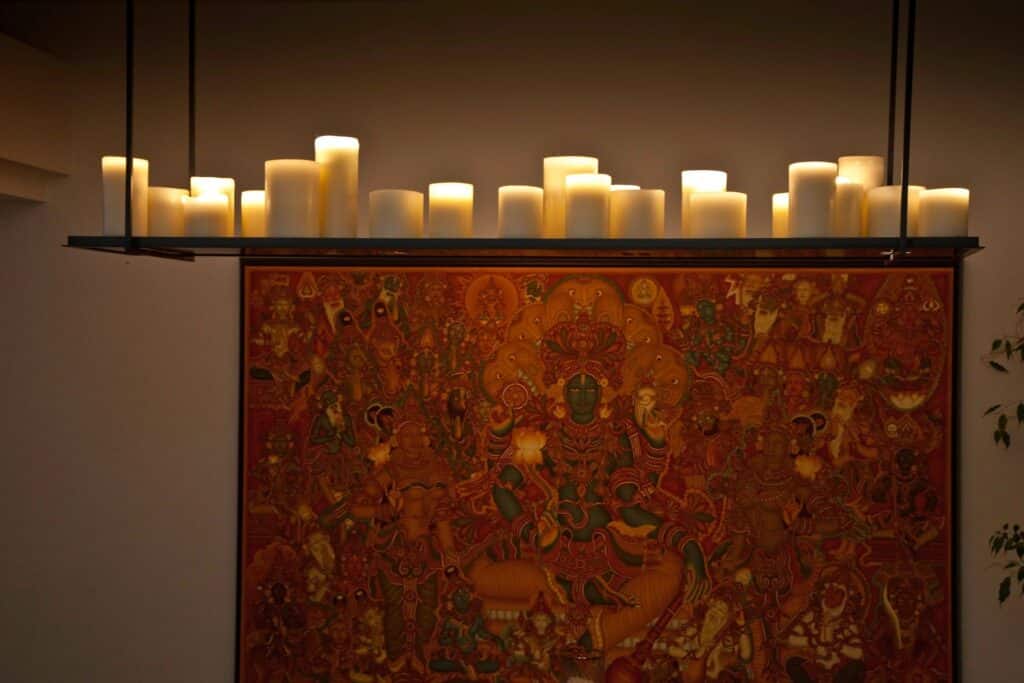
Prioritise Comfort
If you want to be able to meditate with ease and achieve a greater level of stillness, it’s important to ensure that your meditation space is comfortable. To achieve this, use soft furnishings, such as cushions, blankets and throws, to create a nurturing and reassuring environment. In addition to increasing your comfort, using different textures will awaken your senses and help you to focus on the present as you meditate. Where possible, choose natural materials, like linen, cotton or wool, as these will connect you to nature and help you to achieve a heightened state of awareness.
Incorporate Storage
You may not need much in the way of accessories to meditate effectively but many people use candles, crystals or essential oils to turn their attention inward and personalise their meditation space. Alternatively, you may use speakers to play soft music or the sounds of nature as you begin to meditate. If so, incorporating a small amount of storage into your meditation space can be a good way to minimise clutter and promote stillness.
Simple, stress-free storage options made from natural materials are ideal for a holistic meditation space, so look out for wooden or wicker baskets. Similarly, sea grass or bamboo storage baskets and bags can be a functional and aesthetically pleasing addition to your meditation space.
Be Flexible
There are no rights and wrongs when it comes to meditation, so don’t be too focused on creating a meditation space that ‘looks right’. Instead, be guided by your intuition and let your feelings take the reins. Personalising your meditation space gives you the opportunity to create a bespoke sanctuary that caters to your needs and enhances your awareness, so don’t hesitate to add décor or features that are meaningful to you.
Promoting Calmness and Tranquillity Throughout Your Home
Having a dedicated meditation space can certainly enhance your practice and encourage you to meditate regularly, but you can easily extend the design and style of your meditation space throughout your entire home. By doing so, you’ll create a calming, welcoming and tranquil environment that consistently enhances your well-being and reflects your unique personality.
How to Style a Run of Bookshelves
Bookshelves don’t just enhance your interior design; they offer functionality and versatility too. When you’re incorporating a run of shelves in a room, however, it takes some savvy styling to prevent the space taking on the appearance of a library or bookshop. Whether you’re redesigning your living space, overhauling your home office or even curating your own home library, take a look at these top tips for styling a run of bookshelves:
1. Think About How Much Space You’ll Need
If you’re going to install new shelving systems, you’ll want to ensure they’re tailored to your needs. After all, an overflowing bookcase is going to detract from your décor and do little to enhance your interior design.
Take a look at your current collection of books and estimate how much space you’re really going to need. To get an accurate idea, it can be helpful to measure a selection of books and multiply it based on how many books you own.
Remember – if you’re an avid reader or a collector, you’re likely to acquire more books in the future, so factor this into your plans. Furthermore, you’ll want to include a range of other pieces within your shelving system, so be sure to take this into account when you’re planning the space.
2. Reassess Your Interior
Once you know how much space you’re likely to need, you can begin deciding where to situate your bookshelves. You may already have a dedicated space, such as alcove shelving, or a blank wall you need to fill. If not, identify areas in your home that lend themselves to extra features.
Bookshelves can work well in home offices, living areas and even bedrooms, providing you’ve got the space and the room won’t feel cluttered. If you have a large number of books, don’t be afraid to split your collection and feature a run of bookshelves in different areas of your home. By doing so, you can maintain a cohesive design throughout the property, without overcrowding one room.
3. Choose the Right Material
Bookshelves come in an endless range of materials, which means they can be incorporated into any interior. What’s more – it’s easy to repurpose vintage pieces and use them as bespoke shelving units. Whether you’re creating a traditional, cottage-core feel or a contemporary, uber-modern living environment, choosing the right materials for your bookshelves will ensure that they fit seamlessly into your décor. From natural and reclaimed wood to metal, acrylic and glass, there are a wide variety of options to explore.
4. Complement Your Colour Palette
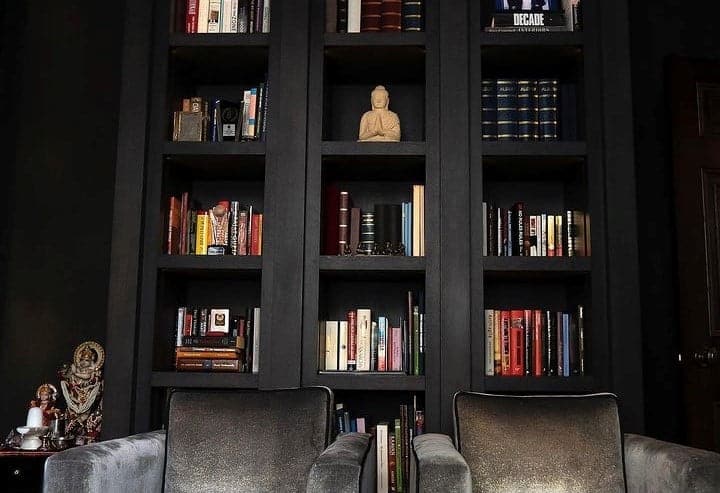
Credit: Shalini Misra - Deep rich charcoal paint on built in cabinetry adds both drama and depth to this home office in one of our recent completed projects.
Depending on the material you choose for your bookshelves, you may be able to modify the colour or finish yourself. This can be a great way to enhance existing shelving units or to upcycle vintage pieces that you want to use for display purposes.
The colour you choose for your bookshelves is going to have a major impact on how conspicuous they are, so think about whether you want them to be a feature in the room or if you want them to blend seamlessly into the background. By painting bookshelves in the same shade as the wall, for example, you can create an unobtrusive feature that doesn’t detract from your décor. Alternatively, a bold or vibrant colour turns your run of bookshelves into an aesthetic focal point.
When you’re selecting the colour of your bookshelves, bear in mind that the books and decorative pieces they’re going to hold will need to complement the shelves themselves. This may mean that choosing a neutral or minimalist shade is the best option. This gives you the flexibility to adorn your shelves with anything you choose, without having to worry about hues competing with one another.
Moody, dramatic shades can create a sense of intrigue and luxe sophistication and are the perfect foil for accent pieces in jewel shades and metallic finishes. Adding smoky and dramatic hues to a bookshelf or library unit bring an understated yet powerful aesthetic to the space.
5. Segment Your Books
For book lovers, segmenting your collection can be the trickiest part of styling a run of bookshelves, but it’s well worth the effort. Some people prefer to segment their books according to the colour of the covers, as this allows you to style your bookcases more easily. Alternatively, you may prefer to segment your books based on their size, so that books of a similar size can be grouped together. This helps to create clean lines once they’re placed on the shelves and enhances their aesthetic appeal.
6. Vary the Placement of Books
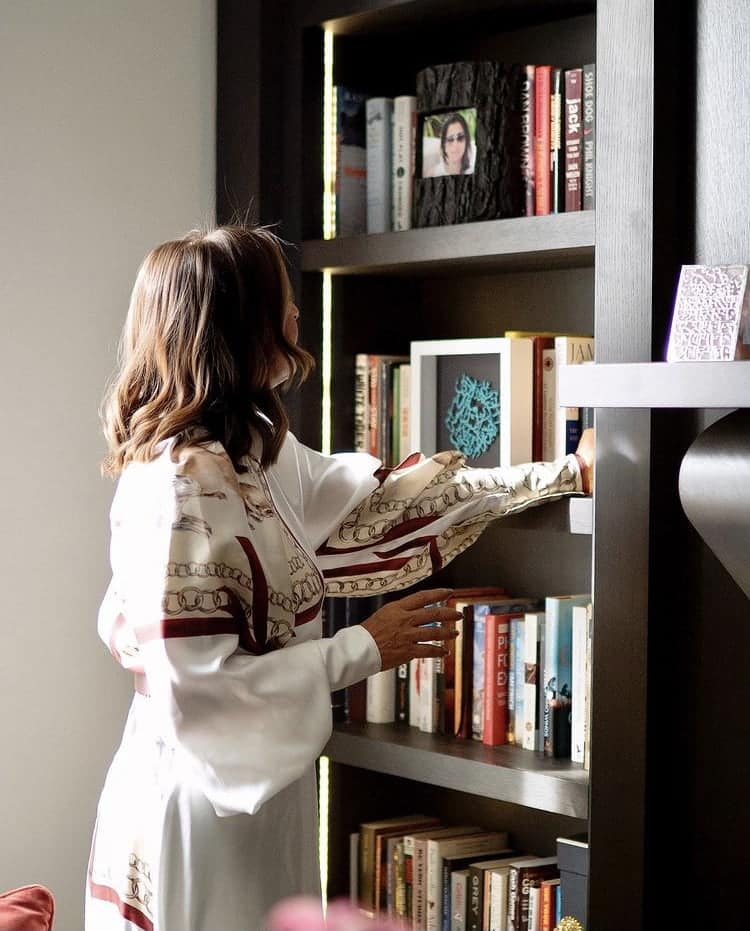
Credit: Shalini Misra
When you begin placing your books on shelves, don’t place them all in the same way. Instead, lay larger books horizontally, stand some books up and leave others leaning against them as a makeshift bookend. This allows you to add creativity into the styling of your bookshelves and prevents them from appearing bland in terms of their design.
7. Leave Blank Spaces
If you’re installing a run of bookshelves in a room, you won’t want to fill each shelf up with books. This can make the area seem too full and even cluttered. Instead, leave some space bare, so that each shelf looks well-styled and carefully thought-out, rather than simply being a storage area for books.
If you want to add an interesting focal point, use artwork in a blank space to complement the décor. You can either hang art behind the shelves and let it be visible or, if the shelves have backing, you can place it directly on the shelf or affix it to the backing.
8. Use Your Favourite Decorative Pieces
As well as using a run of bookshelves to store your favourite literary works, be sure to include your favourite decorative pieces too. Adding a vase, candle, vanity tray or sculpture helps to break up a run of books and adds new elements to your interior design.
Use Shelving to Enhance Your Interior Design
Shelving may serve a functional purpose in any home, but it can also be a key element of your design. When you take a creative approach to styling, a run of bookshelves can be the perfect addition to any room.
How to Style a Bedside Table like an Expert
A bedside table is a staple feature in any bedroom, so much so that it is often overlooked in terms of style. However, any piece of furniture plays an important role in the overall design of a room, which is why it’s essential to choose a bedside cabinet that elevates the theme of a bedroom.
If you’re looking for design inspiration or you simply want to know more about how top designers put the finishing touches to their work, read on to find out how the experts style their bedside cabinets and how you can incorporate their processes into your own redesigns:
1. Extend Your Colour Palette
It goes without saying that the bedside cabinets you choose should complement the style and colour palette of the room as a whole, but don’t stop there. The pieces you use to style your bedside table should be an extension of your chosen colour palette.
There’s no doubt that function is important when it comes to styling a bedside table, but versatility and function don’t have to come at the cost of style. If you want to illuminate the area with a bedside lamp, for example, choose one that uses materials that are present in other features of the room. Similarly, choose hues that are represented in other pieces to create a calming, cohesive environment.
2. Use Height
Using varying heights creates a dynamic and interesting design, rather than the somewhat flat and dull appearance that a single height line offers. Take a look above at how Shalini and her team used to inform the design of the master bedroom in the first London edition of Holiday House.
If you don’t have the space to incorporate multiple bedside tables, there are alternative ways you can use varying heights to alter the proportions and maximise the impact of your bedside cabinet. Adding a tall, elegant bedside table lamp, alongside a smaller vase and miniature alarm clock or bedside tray incorporates three different heights without overcrowding the space, for example.
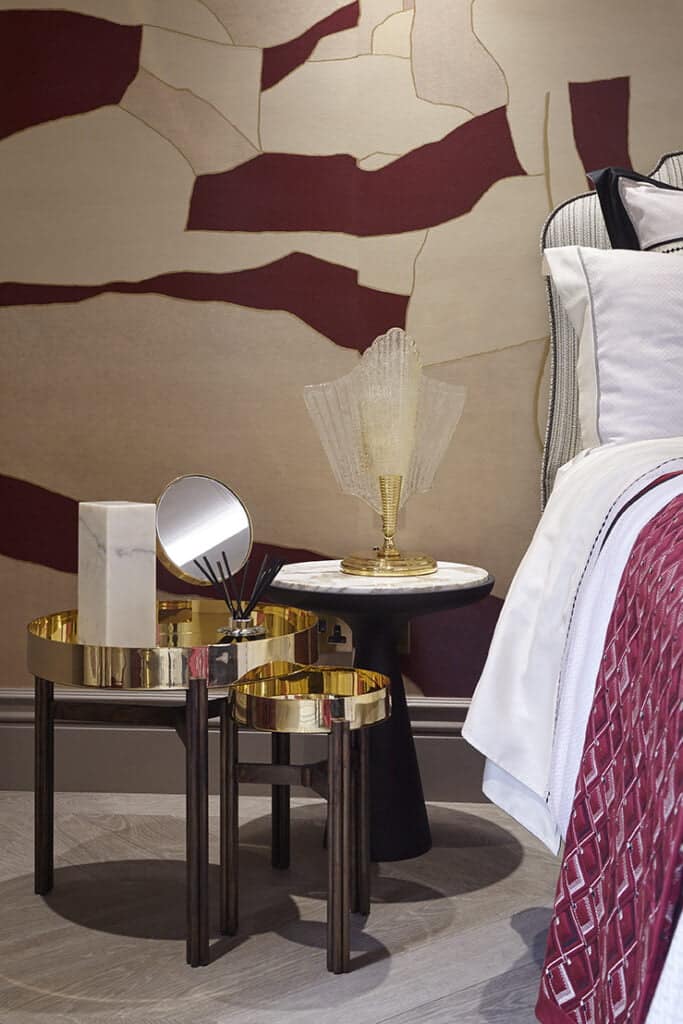
Image Credit - Shalini Misra
3. Add a Personal Touch
Your bedside cabinet may be the last thing you see at night and the first thing you see when you wake up in the morning. As a result, the pieces you choose to put on your bedside table can promote a restful night’s sleep and help to shape your mood for the day. Adding a personal touch to your bedside décor is one way of ensuring it has a positive impact.
Photographs of loved ones or beloved artwork can be ideal for a mid-size addition to your bedside cabinet, while a valet tray is a perfect place to keep sentimental trinkets or jewellery. Alternatively, position a vase filled with your favourite blooms or a luxury candle with your favourite scent on your bedside cabinet. All of these elements can be enhanced by choosing frames, materials and colours that complement your interior design while adding a unique and personal touch to your bedroom décor.
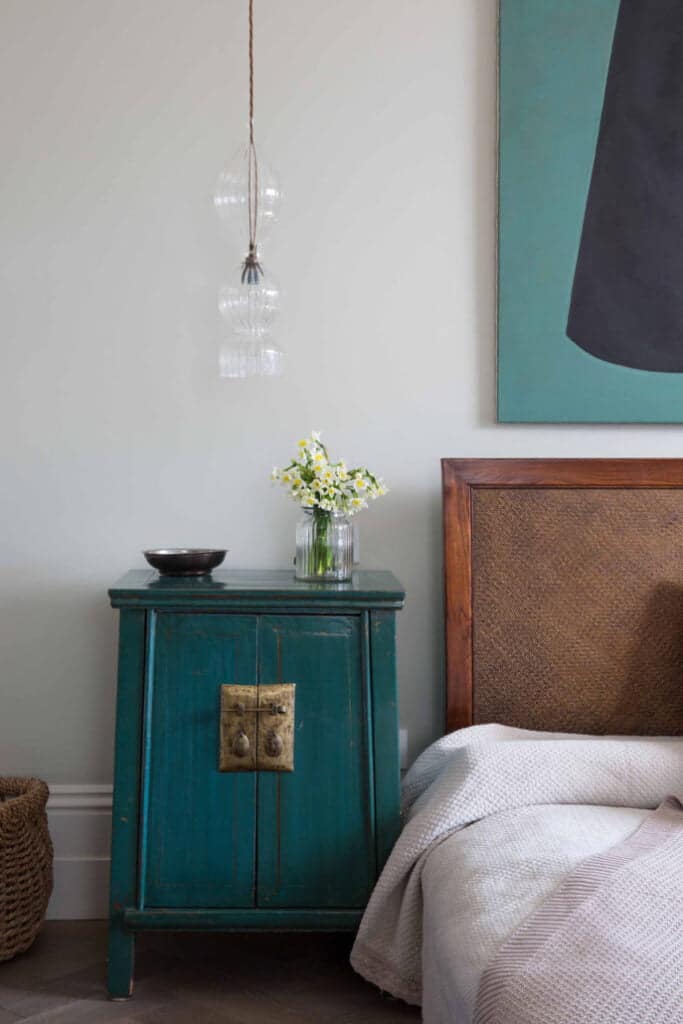
Image Credit - Shalini Misra
4. Keep It Simple
When it comes to styling your bedside cabinets, less is definitely more. It can be tempting to over-style a bedside table, particularly if you want to increase its functionality. However, crowding the space can detract from your carefully chosen design.
If you have a habit of filling your bedside table with books, phones, headphones, or other paraphernalia, choose a cabinet that provides extra storage while keeping items hidden out of sight. This ensures you have the space and functionality you need, without detracting from the design. The top of your cabinet can prioritise decorative pieces, while hidden storage provides the extra space you need.
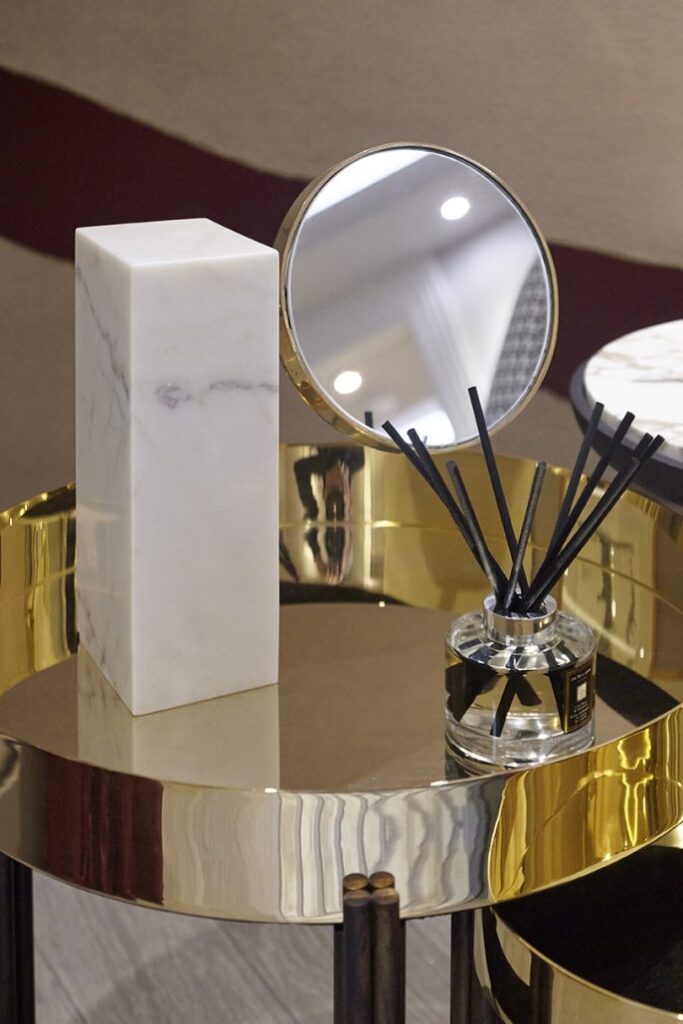
Image Credit - Shalini Misra
5. Use Subtle Symmetry
Styling two cabinets in the same way and placing them on either side of the bed can look spectacular but aiming for perfect symmetry may be unrealistic. Instead, focus on subtle symmetry when you’re styling bedside cabinets. Matching colours or accents achieve cohesive styling, for example, while using the same materials to enhance each cabinet ensures features will complement each other, as well as other pieces in the room. Similarly, using twin lamps or frames can be a great way to create ‘mirror image’ symmetry or can be used as the basis of subtle symmetry styling.
6. Add Depth
A bedside cabinet doesn’t have to be positioned directly against a wall. In fact, moving it away from the wall and using additional features to add depth can have a striking impact. If you’re opting for a bedside table that doesn’t feature extra storage, you can enhance the space by positioning artwork directly behind the table, for example.
An oversized piece that frames the table and its contents does double duty by adding height and depth to your interior design, for example. With complementing colour themes, this can be a spectacular way to achieve a bespoke look that’s understated yet impactful.
Alternatively, choose pieces that incorporate different textures and finishes to create more depth. A metallic bowl alongside a stone or ceramic lamp creates a fabulous aesthetic while using varying textures to increase the depth and effect of the design.
7. Soften the Space
Many people automatically choose bedside cabinets that are square or rectangular in shape, but these aren’t the only options out there. Choosing a circular bedside table or a cabinet with curved legs adds an interesting dimension and softens the space. Bedroom furniture is often angular, but this is one area where it’s easy to incorporate different shapes and silhouettes.
Add the Finishing Touches to Your Bedroom Design
The right styling can ensure that your bedside cabinets complete your room design but don’t overlook the challenges this area can bring. Often situated in a small space, bedside tables need to combine form and function to effectively fulfil their purpose and enhance your décor.
Due to this, you’ll want to think outside the box and be as creative as possible when styling your bedside cabinets. By doing so, you can ensure that your bedside tables are a central element of the space and add the ultimate finishing touches to your bedroom design.



